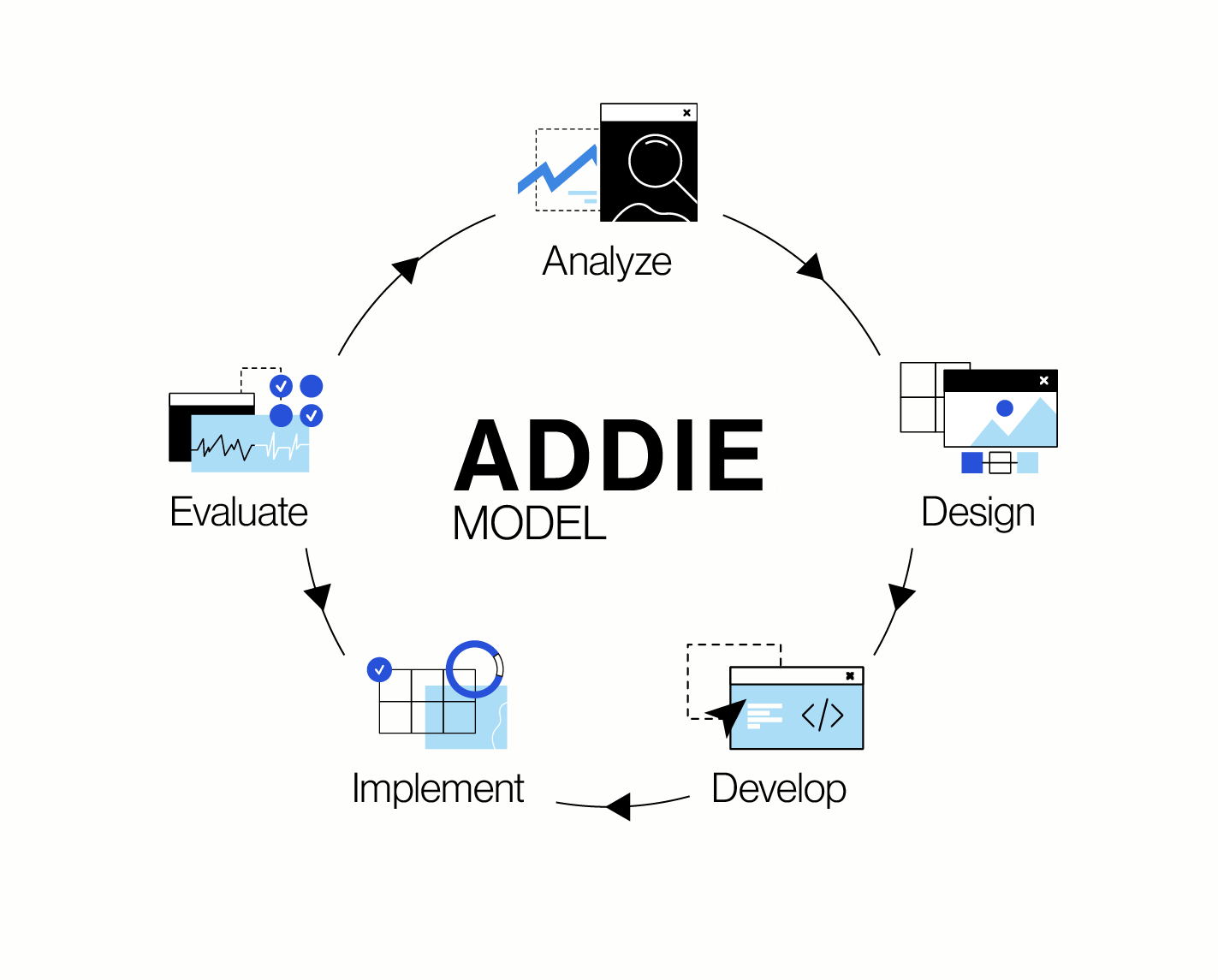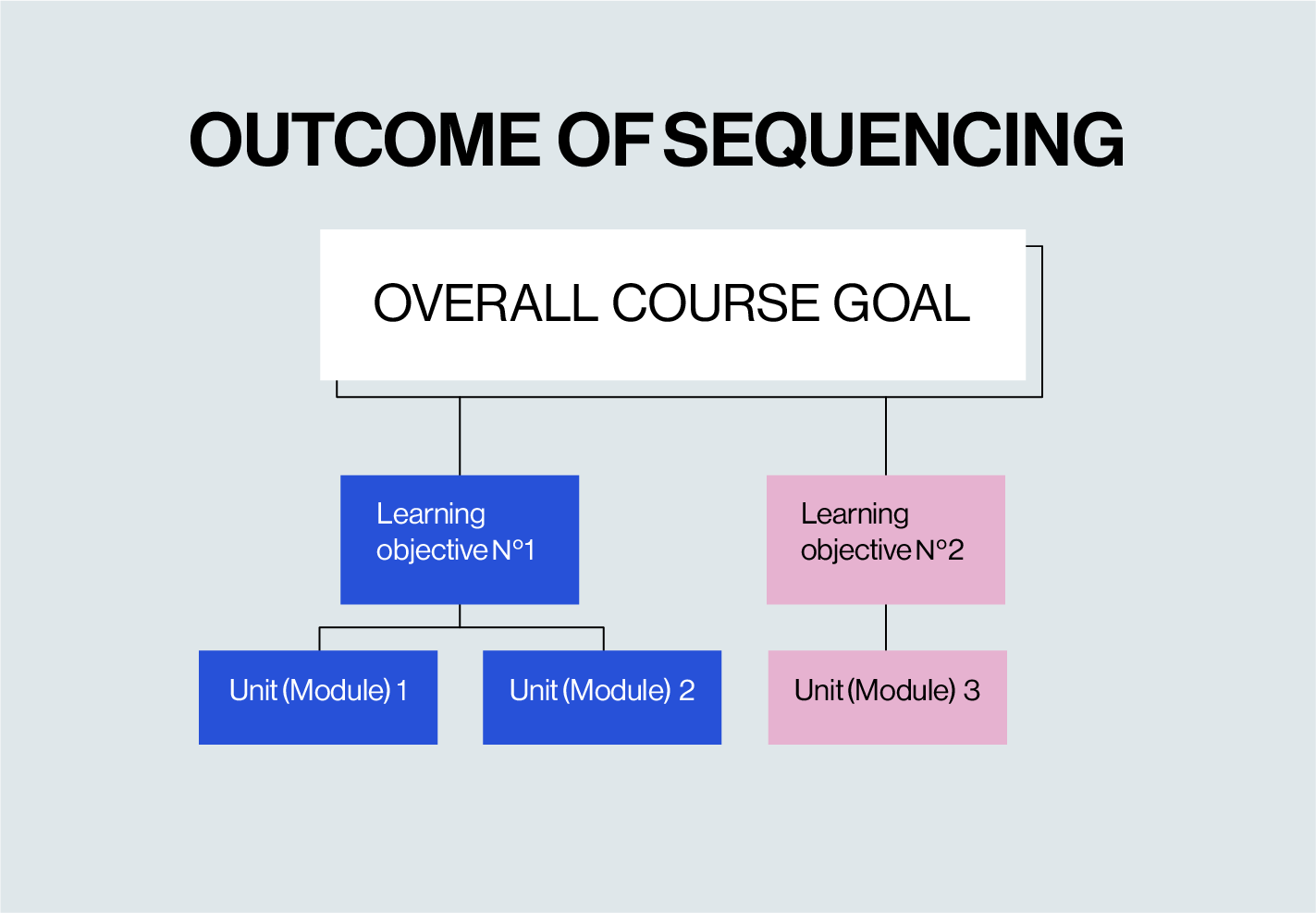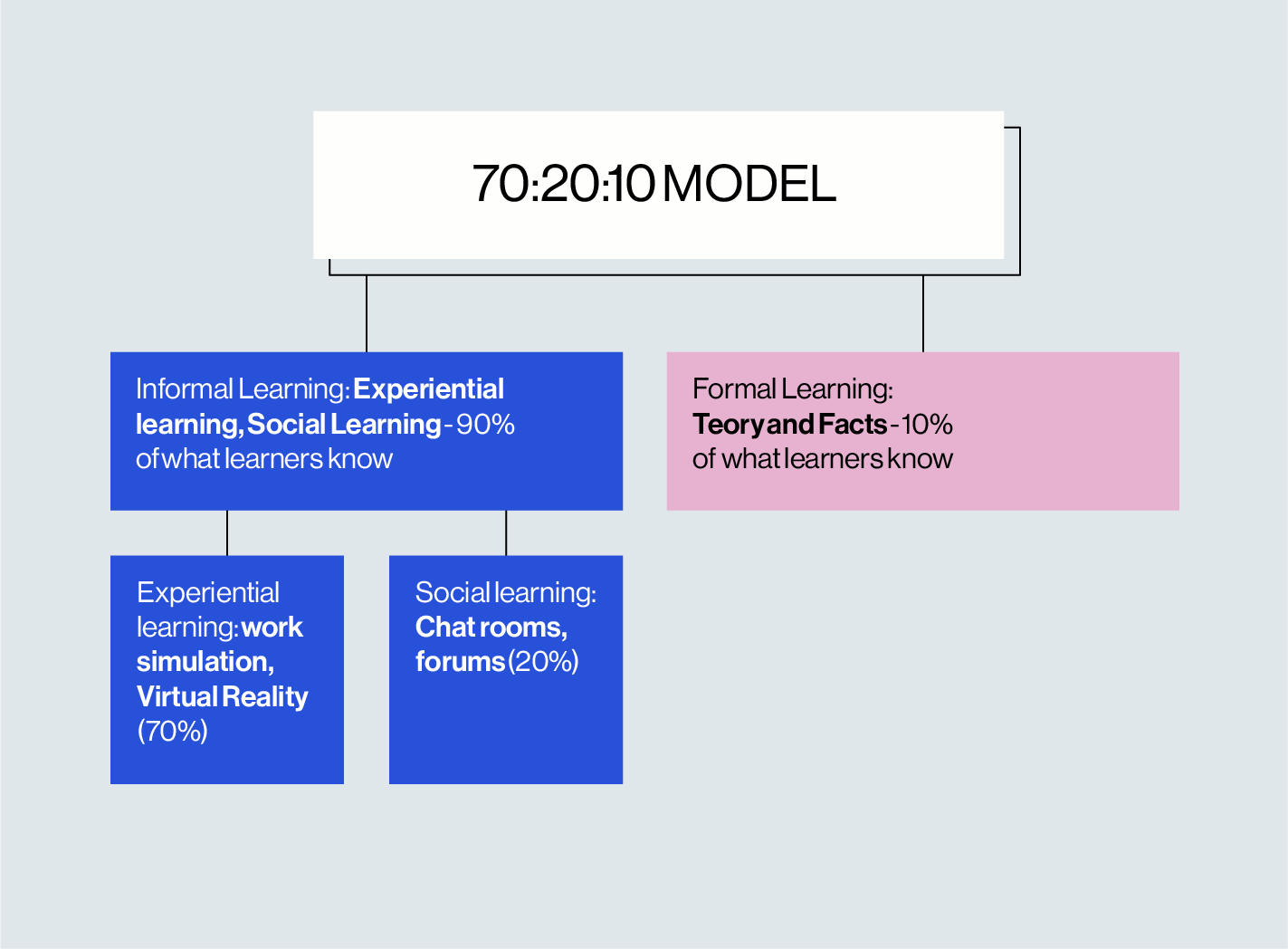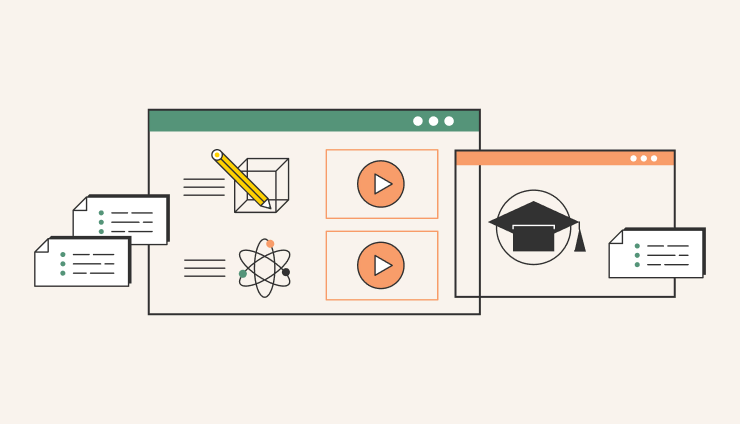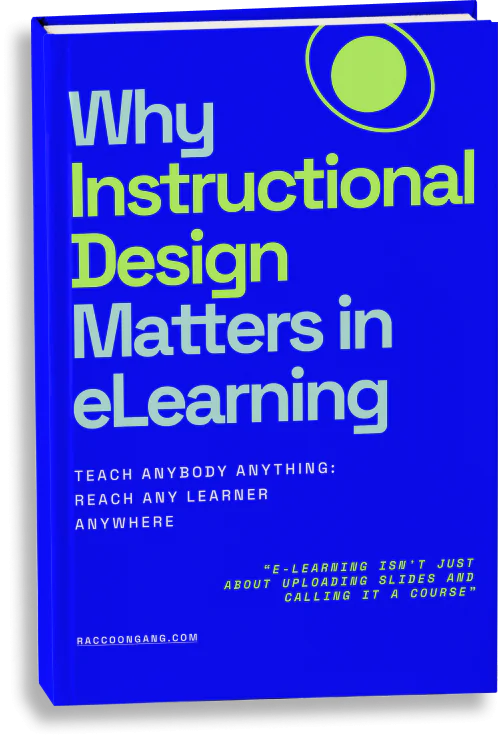This guide presents specific course-building activities to assist instructors in learning how to create an online course, focusing on course development services, organization, and evaluation while emphasizing basic theory and best practices”.
There are many instructional system design models, most of which are based on popular ones, such as the ADDIE model.
Using the RACI Matrix, we will describe each step from the needed roles and responsibilities perspective and give you the estimated time frames for each stage based on our online course development costs estimator.
ADDIE Explained
The ADDIE Model is a framework used to design and develop effective learning experiences. It is an acronym for Analysis, Design, Development, Implementation, and Evaluation. Educators have used the Model in educational settings since the 1970s.
ADDIE Model: The process
The ADDIE Model consists of five distinct stages. Each stage involves activities aimed at understanding the needs of learners and designing instruction that meets those needs.
- Analysis
- Design
- Development
- Implementation
- Evaluation.
At each stage of the process, we should gather feedback from stakeholders (e.g., learners and instructors). This is a necessary part of future success, no doubt.
ADDIE Model: Roles
There are various roles within the ADDIE Model that are responsible for different aspects of the instructional design process. These include:
- Instructional Designers who analyze learner needs and design instruction;
- Developers who create instructional materials; Implementers who deliver instruction;
- Evaluators who assess outcomes of instruction both during and after implementation.
ADDIE Model: Responsibilities
- The Instructional Designer is primarily responsible for analyzing learner needs and designing appropriate instruction based on those needs.
- Developers create instructional materials such as course content, assessments, job aids or other learning tools based on the Instructional Designer’s specifications.
- Implementers support instruction delivery. They guide instructors and facilitators during delivery sessions.
- Finally, evaluators measure outcomes.
ADDIE Model: The process, Roles and Responsibilities
The infographic below describes the primary explanation of the ADDIE model. This article will explore each of these stages in depth.
The ADDIE Model Includes Five Steps:
1. ANALYZE:
Needs – analyze the essentials for your online course.
Target audience – analyze your learners and gather as much information as possible on them.
Goals – analyze your broad goals for the course.
2. DESIGN:
Learning objectives – identify what specific skills and knowledge you wish students to obtain.
Sequence – design the course sequence of the course content.
Instructional strategy – combine the content and the various resources, tools, and evaluation methods into one system.
3. DEVELOP:
Content – what media and resources will be used to support the eLearning efforts?
4. IMPLEMENT:
LMS – How will you organize your course delivery?
Course content delivery tools – What communication tools will you use to support your eLearning activities?
5. EVALUATE:
To perform the ADDIE model activities, you should coordinate your course development team and set the leading roles and responsibilities. We highly recommend using a RACI matrix to simplify this process and indicate prominent team roles and workforces.
RACI matrix for roles of the ADDIE model
R – Responsible – is the person who performs the task. There should be at least one responsible per task.
A – Accountable is the person who is ultimately answerable for the correct and thorough completion of the deliverable or task and the one who delegates the work to those responsible.
C – Consulters are those whose opinions are sought, typically the subject matter experts.
I – Informed persons are kept up-to-date on progress; generally, they only complete the task or deliverables.
| Role | Analyze | Design | Develop | Implement | Evaluate |
| Instructional designer | R | R | C | C | R |
| Subject Matter Expert | C | C | C | ||
| Technical Developer | I | R | C | ||
| Translator | C | C | |||
| Media Creator | I | R | |||
| Technical Support Specialist | C | C | C | ||
| Course Administrator | A | A | A | A | A |
| LMS site administrator | I | I | C | ||
| Instructor | C | C | C |
Main roles in course creation
The instructional designer (ID) is responsible for the overall instructional strategy. During analysis and course design, the ID works with Subject Matter Experts to define the necessary skills and knowledge for the course. Together, they choose the appropriate instructional strategy.
- The Instructional designer also plays a notable role in media production as the ID manages and validates the assets and deliverables for the design and development stages.
- Subject Matter Expert (SME) contributes to the knowledge and information required for each course. SME collaborates with the ID to design the course and define evaluation strategies.
- Media Creator is responsible for creating media content for the online course.
- Technical Developer (TD) is responsible for implementing the online course content delivery.
- Translator (optional). The TD does the localization with the contribution of the translator. Translators may also be used to produce translated text for narration or scripts for video.
- The technical Support Specialist (TSS) is responsible for ensuring that the necessary software tools are working correctly and assists producers and users of the online course at every stage of the process.
- Course Administrator is the Product Owner and individual who enrolls trainees in the course or validates requests.
- LMS Site Administrator is a staff member responsible for managing the eLearning platform, providing daily support, and keeping the ongoing operations of the eLearning platform LMS stable.
- Instructor. In the case of blended learning, they play an essential role in the course support. Whereas in self-paced learning, the position is more oriented toward providing answers to the learners through communication channels (email exchange, discussion forum, etc.).
The navigation board of the ADDIE model, shown below, will help you to better orient yourself in the process of creating an online course.
ADDIE Model Navigation Board
| Analyze | Design | Develop | Implement | Evaluate |
| Needs | Learning objectives | eLearning content | LMS | |
| Target audience | Sequence | Course content delivery tools | Course outcomes | |
| Goals | Instructional strategy |
ADDIE Step 1: Analyze (Estimated 30-40 hours)
| Responsible person | Consultant person | Accountable person |
| Instructional designer | Subject Matter Expert | Course administrator |
Analyze Needs
In our case, the need analysis represents the gap between the current level of skill and knowledge and the desired level of performance the organization wants to achieve. After the needs analysis, you will have an excellent foundation for your learner persona.
Analyze the Target audience
Every student is different, so it’s a good idea to make your course suitable for your target audience from a behavioral perspective. Shift LMS creators propose a classification of learners from a behavioral perspective.
Classification of learners from a behavioral perspective
| Types of learners | Personal Characteristics | Recommended attitude |
| Confident learners | Believe they are capable of doing everything | Encourage learners to earn more points for additional assessments |
| Emotional learners | They want to be connected either with an instructor or course content | Leverage social and collaboration tools The storytelling approach may help you to connect with learners |
| Unmotivated learners | Lack of enthusiasm, they are likely to drop the courses | To use microlearning To Use adaptive learning to increase engagement. Design eLearning gamification Implement mobile learning |
| Risk takers | They enjoy exploring new ideas and discussing complex questions | Encourage your students to create materials and content Employ different collaboration tools; give them challenging group tasks |
| Depending learners | They work diligently, frequently ask for help, and feel insecure about their answers | Provide self-assessment tools for such learners. This may help them identify areas of weakness and seek resources and guidance |
| Motivated learners | They have specific goals and are willing to work hard to overcome any difficulty | Create a rewards system to ignite the competition |
Formulate Goals
Goals are general statements about what you hope students will gain from your course and which “gaps” will be filled. Generally, a course goal is stated as “Students will gain an understanding of” or “Students will develop an appreciation of.” The nature, definition, and assessment of goals will vary depending on defined Gaps. As a result, there are several different ways goals can be articulated:
- Focusing on benefits. You should define course goals broadly, focusing on the anticipated benefits to students from participation in a course program. For example, after finishing this course, students will get Critical thinking, Creative writing, Research skills, Communication skills, etc., depending on the learning discipline.
- Focusing on the action. If you want to understand How to implement eLearning in an effective manner, you should keep in mind the subject of your courses and define a course goal. You should complete this phase by describing what students should and/or will be able to do by the end of the program. When your audience’s needs, personas, and course goal(s) are defined, you are ready to start the Design step.
ADDIE Step 2: Design (Estimated 134-184 hours)
| Responsible person | Consultant persons | Accountable persons | Informed person |
| Instructional designer | Subject matter expert | Course administrator | Technical developer |
| Technical support specialist | Media creator | ||
| Instructor | LMS site administrator |
After the course analysis and design, you should start the content creation process.
But beforehand, you need to define How to structure your online course and what types of content you want to see in your online course. Clearly, stated Learning Objectives come in handy at this stage.
How to Formulate the Learning Objectives
1. Setting Learning Objectives
Learning goals and learning objectives are directly connected. To understand the connection between them, consider the learning plan as a strategic category and the learning objective as a tactic category: What objectives should you set to reach the goal?
Learning Objectives are specific statements that include both an action verb and a content reference. Objectives are not broad, long-term goals such as “improving students’ ability to communicate.” According to the Carnegie Mellon University, practical learning objectives should be compliant with the following statements:
- Learning Objectives must be student-centered
- Learning Objectives must be both observable and measurable
Learning objectives should be formulated in a way that helps the learner understand how it will help them reach their Learning Goal. Such learning objectives will motivate learners to move towards this goal.
Articulating your learning objectives can be challenging at first. Here are some resources to help:
- Writing Measurable Learning Objectives – Arizona State University
- Samples of learning objectives – Carnegie Mellon University
After determining the online course goals, create a course outline. This can be as simple as a topical outline or as detailed as a storyboard (or both).
2. Determine Sequence
Defined learning objectives are the basis for course structure and sequence. Different methods can be applied to design the best structure for your course. Course structuring methods depend on the learning goal(s).
In a job-oriented course, the content can be organized to follow the order of the actions in a natural job environment; this is the job-context principle.
In a non-job-oriented course, concepts can be organized according to their structural connections, such as by:
- describing the characteristics of a class before describing its members;
- providing examples first, then definitions;
- starting with concrete information and then proceeding to abstract or complex concepts.
The outcome of the sequencing is an accurate course structure where each element corresponds to a specific learning objective and contributes to the achievement of the overall course goal(s).
After all, the instructional designer should propose the best mix of methods and techniques in each online course structure segment.
3. Define Instructional strategy
An instructional strategy is a long-term, high-level plan for accomplishing course goal(s) through available learning resources (the methods, techniques, and devices used to instruct learners).
The Instructional designer should bind learning and design theory knowledge with accumulated information from learning goals, objectives, and target audience analysis to create the instructional strategy.
The instructional strategy states what instructional methods should be used in a particular online course.
There are three types of instructional methods:
- Expositive methods emphasize the “absorption” of new information. These methods include presentations, case studies, work examples, and demonstrations.
- Application methods emphasize the active processes learners use to perform principle-based tasks and build new knowledge. Application methods include demonstration-practice methods, job aids, case-based or scenario-based exercises, role-play, simulations and serious games, guided research, and project work.
- Collaborative methods emphasize the social dimension of learning and engage learners in sharing knowledge and performing tasks in a coordinated way. They include online guided discussions, collaborative work, and peer tutoring.
By the end of the Design stage, we will have:
- Defined knowledge/skill gaps.
- Defined learner types.
- Set online course goals.
- Stated learning objectives and outlined the online course structure.
- Chosen an instructional strategy.
Having all the above on your plate, you can move to actual content development.
ADDIE Step 3: Content Development (Estimated 125-235 hours)
| Responsible person | Consultant persons | Accountable person | Informed person |
| Technical Developer | Subject Matter Expert Instructional designer Translator Technical Support Specialist and Instructor |
Course administrator | LMS site administrator |
Using Learner’s needs analysis, you can identify how your target audience will study better. ID guides you with an eLearning strategy, and you are almost ready to create excellent learning content. To succeed, you should use the best practices of the 70:20:10 model and develop course content and activities according to Bloom’s taxonomy.
Bloom’s Taxonomy
If you’re new to online course creation, consider Bloom’s Taxonomy to balance your course activities while engaging a diverse group of learning styles with one all-inclusive course curriculum. Traditional educators have been using Bloom’s Taxonomy since the late 1940s.
In the taxonomy, learners start at the base layer, or the “Remember” step, and work their way up as they master the content in the increasingly complex layers. The infographic includes a few suggested activities that apply to the experience of learning online.
But how can Bloom’s taxonomy be used in content creation practice? It is directly connected with Course Outline and Learning Objectives:
- Your course outline is a sequence of content materials to reach your learning objectives.
- Action Keywords represent your learners’ checkpoints that help them achieve Learning Objectives.
Use the action keywords described above to create the most effective content to reach some checkpoints on the way to the Learning Objective.
Below are some examples of how to choose applicable pieces of content for some real-world cases of online course creation:
| Taxonomy Stage | Comprehension level | Action Keyword | Applicable type of content |
| Remembering | Students can recall and remember the information | Recall | In-video quiz; Infographic; “check yourself” quiz |
| Understanding | Students can explain ideas or concepts | Explain | Explainer video; group task; group discussion |
| Applying | Students can use information in a new way | Use | Workplace simulations; scenario-based game |
| Analyzing | Students can distinguish between different course parts | Distinguish | Interactive Whiteboard; graph builder |
| Evaluating | Students can justify a stand or decision | Justify | Case study; group discussion; scenario-based game |
| Creating | Students can create their plans to solve the final course project | Create | Project task; group project task |
While creating your course content, leverage modern techniques of engaging students, such as Gamification, VR, Immersive Learning, and others.
70:20:10 Model for Learning and Development
Effective learning comes down to getting the mix between formal and informal learning just right with the 70:20:10 model. 70:20:10 is a ratio of McCall’s research, which revealed that informal learning.
70% of experiential learning and 20% of social learning are responsible for 90% of what learners know. Informal learning is usually less structured and more spontaneous than formal training.
The last 10% comes from learning, where the content is based on theory and facts. Formal learning gives the facts, figures, and solid foundations to build the remaining 90% of students’ development.
The exact figures of the 70:20:10 model are not the “golden ratio” but are handy landmarks.
Experiential learning – 70%
A massive 70% of what students know is learned through hands-on experience, daily tasks, and challenges. You should think about how to create the best learning practices to improve your students’ skills in the real world. Virtual Reality and work simulation are great tools for modern learning and custom eLearning development. Using such tools, you can bring a fantastic learning experience in a safe virtual learning environment.
Social learning – 20%
Learning doesn’t happen in isolation. McCall’s research discovered that students learn through their relationships by sharing knowledge and observing others. Social learning is another type of informal learning because it is usually self-directed, spontaneous, and less structured than formal learning. You can use social features to encourage your students and share the course content.
For example, you could create chat rooms where organization staff can share their specialist knowledge and know-how with others and answer questions. All this collaboration and communication feeds into 20% of learning that comes from social interactions.
Formal learning – 10%
Formal learning is an essential part of any learning strategy. It forms the basis of successful learning.
Formal learning is a support frame and amplifier for learning. Whatever you create, you should make sure that this essential part of learning is engaging. This helps make the benefits and purpose of the training clear and shows learners why their development matters.
Mobile learning technologies can deliver essential formal training wherever and whenever learners need it – straight to their smartphones. So, whenever students need help, they will have the proper training to hand.
Let’s recap what should be ready at the end of the Development stage:
- Defined needs and identified the target audience.
- Defined the Learning Goal and a general approach.
- Developed Learning Objectives and outlined the online course structure.
- Chosen an Instructional Strategy for each Learning Objective.
- Selected an Action Keyword for each Comprehension Level of each Learning Objective.
- Planned applicable pieces of content for each Action Keyword.
- Created course content using the 70:20:10 approach.
The next step is to create an environment or to deliver your content to learners – the “Implement” stage.
ADDIE Step 4: Implement (Estimated 62-83 hrs)
| Responsible person | Consultant persons | Accountable person |
| Media Creator | Instructional designer Technical Developer Translator Technical Support Specialist LMS site administrator Instructor |
Course administrator |
The implementation phase is delivering the online course content to students. To do this, you need to create an infrastructure that includes the following elements:
-
Course Content Delivery Tools
A learning management system, or LMS, facilitates the delivery and management of all learning offerings, including online, virtual classroom, and instructor-led courses. It automates the online course and efficiently delivers training, manages learners, and keeps track of their progress and performance across training activities, which reduces administrative overhead.
There are two types of LMS:
-
Proprietary LMS software is licensed under exclusive legal rights, restricting modification, further distribution, reverse engineering, and other uses. These systems are closed-source and require license costs per user. Some popular Proprietary LMSs: TalentLMS, Litmos, iSpring, NEO LMS
-
Open-source LMS works under the terms of the GNU General Public License. The license guarantees the freedom to share and change the program. Good examples of open-source LMS are eFront, Moodle, and the LMS we focus on — Open edX.
There are a lot of resources that can help you choose the LMS that would suit you best. Please Contact Us so we can help you understand whether Open edX is a way to go.
Some LMSs have the necessary content delivery tools for content digitization, organizing online webinars, arranging files and video hosting, etc.
However, many organizations use additional content delivery tools like chats, animations, eLearning authoring tools, etc.
ADDIE Step 5: Evaluate
| Responsible person | Accountable person |
| Course administrator | Instructional designer |
What is the purpose of the evaluation? Evaluating your online course outcomes can give you a powerful impulse for further development. For example, you can improve your content to increase engagement. The Kirkpatrick model describes best practices for evaluating online courses.
Evaluating learners’ reactions means understanding how those who participate in the program react to the course. In facilitated online training, learners’ participation is monitored by the facilitator throughout the course period. It can be measured through questionnaires and surveys, usually submitted to learners at the end of the online course.
Evaluation (or assessment) of learning measures the achievement of intended learning objectives. Depending on the type, this can imply that participants have increased knowledge, developed skills, and changed attitudes due to attending the course. Talking about corporate training is more effective to use ROI measurement techniques to estimate the expected outcomes of the training.
You can conduct evaluations to accomplish the purposes. First, decide whether you want to evaluate the course during the development stage to improve it before finalization. Otherwise, you can measure the effectiveness by the end of the course.
In other words, you may want to evaluate a course:
- During the development stage, to improve instructional courses or products (formative evaluation);
- During or immediately after the implementation stage, measure the effectiveness of education training and learning (summative evaluation).
Conclusion
Actual course creation can be tricky, but if you know your audience and core message, you will just need the right people for the corresponding roles – eLearning specialists will do the rest when you’re good with the basics. Explore different instructional design models to enhance the structure and delivery of your content. After your first run through the five steps outlined in this post for online course creation, it will become increasingly easier to build future courses.
Raccoon Gang has in-depth expertise in creating custom eLearning solutions for eLearning businesses in different domains. Our experts can consult you on creating an online course. All you need to do is drop us a line, and our representative will contact you within 24 hours.
FAQ
What are the first steps in creating an online course?
Which platform is best for course creation?
What are the five steps in the ADDIE training process model?
1. Analysis: This step involves identifying the needs and goals of the training.
2. Design: This step involves creating a detailed plan for the training, including the content, activities, and assessments.
3. Development: This step involves creating the actual training materials and activities, such as slides, videos, and exercises.
4. Implementation: This step involves delivering the training to the target audience.
5. Evaluation: This step involves collecting and analyzing feedback on the training.
What is the first step in the ADDIE training process?
How do you formulate a course?
1. Identifying the goals and objectives of the course.
2. Determine the target audience.
3. Develop a course outline.
4. Create the course materials.
5. Determine the delivery method.
6. Plan assessments.
7. Review and revise.
- ADDIE Explained
- ADDIE Model: The process, Roles and Responsibilities
- The ADDIE Model Includes Five Steps:
- RACI matrix for roles of the ADDIE model
- ADDIE Model Navigation Board
- ADDIE Step 1: Analyze (Estimated 30-40 hours)
- Classification of learners from a behavioral perspective
- ADDIE Step 2: Design (Estimated 134-184 hours)
- How to Formulate the Learning Objectives
- ADDIE Step 3: Content Development (Estimated 125-235 hours)
- ADDIE Step 4: Implement (Estimated 62-83 hrs)
- ADDIE Step 5: Evaluate
- Conclusion

